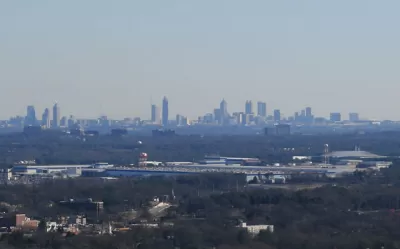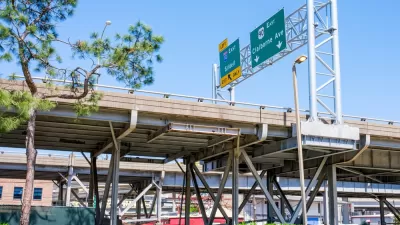The practice facility for a new Major League Soccer franchise was made possible by the demolition aging and affordable apartment buildings.

Joe Cortright writes: "For a couple of years now, we’ve been following the story of Marietta, Georgia, where local officials used $65 million in taxpayer funds to buy up and begin demolishing some 1,300 apartments along Franklin Road." A previous article by Cortright on the Marrietta case study explored the idea of suburban displacement. This time around, Cortright compares it to the poor example set by urban renewal practices of the mid-20th century.
The apartments are making way for a "verdant practice facility" to support a new Major League Soccer team, called the Alanta United. But as "hundreds of old but serviceable apartments were demolished to make way for these spacious fields," argues Cortright, the whole situation "is a striking case where the displacement of low income families was an explicit objective of public policy, rather than the side-effect of a changing real estate market."
If that all sounds familiar, that's because Marietta is taking a page from the same urban renewal playbook that many planners and urbanists consider a relic of the regrettable past. Cortright documents the changes in Marietta as the demolitions move forward along Franklin Road, which has now been renamed as Franklin Gateway, by sampling Google Street View images.
For the record, this isn't the first time that the words "urban renewal" have made an auspicious appearance in the urbanism news cycle. As Emily Badger noted in a New York Times article in December, President Donald Trump has used the words to describe his proposal for a "New Deal for Black America"—seemingly unaware of their fraught history and the discriminatory practices they connote.
FULL STORY: Suburban Renewal:

Alabama: Trump Terminates Settlements for Black Communities Harmed By Raw Sewage
Trump deemed the landmark civil rights agreement “illegal DEI and environmental justice policy.”

Planetizen Federal Action Tracker
A weekly monitor of how Trump’s orders and actions are impacting planners and planning in America.

The 120 Year Old Tiny Home Villages That Sheltered San Francisco’s Earthquake Refugees
More than a century ago, San Francisco mobilized to house thousands of residents displaced by the 1906 earthquake. Could their strategy offer a model for the present?

In Both Crashes and Crime, Public Transportation is Far Safer than Driving
Contrary to popular assumptions, public transportation has far lower crash and crime rates than automobile travel. For safer communities, improve and encourage transit travel.

Report: Zoning Reforms Should Complement Nashville’s Ambitious Transit Plan
Without reform, restrictive zoning codes will limit the impact of the city’s planned transit expansion and could exclude some of the residents who depend on transit the most.

Judge Orders Release of Frozen IRA, IIJA Funding
The decision is a victory for environmental groups who charged that freezing funds for critical infrastructure and disaster response programs caused “real and irreparable harm” to communities.
Urban Design for Planners 1: Software Tools
This six-course series explores essential urban design concepts using open source software and equips planners with the tools they need to participate fully in the urban design process.
Planning for Universal Design
Learn the tools for implementing Universal Design in planning regulations.
Clanton & Associates, Inc.
Jessamine County Fiscal Court
Institute for Housing and Urban Development Studies (IHS)
City of Grandview
Harvard GSD Executive Education
Toledo-Lucas County Plan Commissions
Salt Lake City
NYU Wagner Graduate School of Public Service




























